My typical conversation with a tour company used to go like this:
[me a.k.a. sustainability fighter] — You know, as a tourism industry we should be more sustainable and take more responsibility for our actions…
[a local tour company ] Yes, I totally agree! It’s just… not for me now. But as soon as I have more time, and more money, I’ll be do it. Promise!
I’ve been quite annoyed hearing it over and over. I couldn’t understand why someone wouldn’t want to be sustainable and responsible from the day 1. Then I understood that I’m the “captain planet” type of a person, and others want to make a living.

Look closer
The problem is that the “perfect” moment with more time and money never comes. Even if your tour company has extra money, you’ll want to use it to scale: hire more staff, produce better marketing materials, rent an office space. Anything that doesn’t directly contribute to a business’’ growth will always drop to the bottom of a priority list.
That’s why the traditional CSR (corporate social responsibility) approach doesn’t work for small and medium tour businesses. Most of CSR actions bring benefits to external organisations, and not for the business itself. Those that bring benefits, like PR-worthy fundraising campaigns and staff volunteering schemes, are out of their reach.
Very often, local businesses are inherently more sustainable and eco-friendly than the bigger ones because they are naturally closely connected to their communities, where people support one another. Also for most small tour provider, the tourist destination is their home, so they respect, care and love it more than almost anyone else.
But does it mean that being a local business in enough?
Aim higher
The sustainability bar in tourism is now higher than ever before.
On one hand, customers expect that you pay taxes, pay fair wages, don’t hire children, don’t harm animals, and that you generally are a responsible business. These are no-brainers, at least in the Western world.
Trends are also changing. Travellers, even the mass tourists, seek out local and authentic experiences. A few years ago taking tourists to a local restaurant would make you stand out but nowadays, using local in a tour description is nothing more than another marketing buzz-word.
On the other hand, over tourism is real. More and more destinations have troubles managing the influx of visitors. A small local tour business is part of the problem as much as any foreign travel company. The anti-tourism protesters would probably suggest that tourism businesses should close altogether. But what if this isn’t an answer?
The big question is then, so what’s next? If paying taxes is not enough, and CSR campaigns are not a solution, what does social and economical responsibility mean for a local tour company?
Social and economical responsibility of a local tour company should be measured by whether it creates win-win situations for all its stakeholders (shareholders, employees, customers, community, suppliers), or in other words — whether it creates a shared value.
“The principle of shared value involves creating economic value in a way that also creates value for society by addressing its needs and challenges. Businesses must connect company success with social progress. Shared value is not social responsibility, philanthropy or even sustainability but a new way of achieving economic success. It is not on the margin of what companies do but at the center.” (Creating a shared value, Harvard Business Review 2009)
Creating a shared value means creating economical and societal progress by innovating products, redefining supply chains and developing local clusters.
Hack it
In practice, it means that a tour business should be solving its major business challenges using solutions that also benefit the community it is part of.
And what are the key challenges an average tour business needs to solve?
- How to sell more tours
- How to sell tours for more $$
- How to optimise tour operations to scale faster
These shouldn’t come as a surprise. A tour lies at the core of a tour operator’s business, and so it is the single most important determinant of its success. That’s why tour companies will always be looking for ways to design the most interesting routes, to attract, to train and retain the best guides, and to offer the best value for its customer’s dollar.
And the only way for a tour company to win both the profitability and social responsibility game is to find a way to solve these tasks through mutually beneficial partnerships with the local community.

But how?
I have listed the 6 key components of an average tour, proposing a few solutions for each. You don’t need to go all in. Pick one, start small. Remember, you can make a difference one tour at a time.
1. Guides
A guide’s role can’t be overemphasized. A guide is a front (wo)man, storyteller, brand ambassador and salesman all in one. To enhance their importance, G Adventures calls guides the CEOs (Chief Experience Officers). Having competent, passionate, engaged, and most importantly, loyal guides is a dream of every tour company. Yet, finding a perfect guide is not easy. Those with high qualifications might be having high financial expectations. Those with wide previous experience might have a guiding style that doesn’t necessarily reflect your company’s values.
The International Labor Organisation is alarmed about the vast employment challenge. On one hand, the world needs more jobs for the millions of unemployed people, and on the other, businesses need skilled employees that are not so difficult to find. To meet this gap, businesses should work closely with schools and universities to create a more relevant curriculum. Hundreds of businesses and social enterprises around the world develop their own capacity building programs to find the right people.
There are a few great examples of this approach in the hospitality sector. Soria Moria Hotel in Siem Reap trains and hires locals from disadvantaged backgrounds through its educational and trainee programs. To empower ownership, Soria Moria employees are also its shareholders.
A few local tour and activity providers do a great job hiring and integrating unprivileged groups too. Migrantour is a European network promoting guided walks that are led by citizens from migrant backgrounds, designed to promote intercultural diversity. Unseen Tours (London) and Shades Tours (Vienna) are social enterprises that work with homeless and formerly homeless individuals, coaching them to lead city walking tours.
You don’t need to turn your business into a social enterprise. Collaborate with a local tourism school and co-create a training program for their students. The risk here is very low and the benefits are high. Not only will you get well-trained guides who understand your brand but you will also contribute to the increase of youth employability in your destination.
Think out of the box and look at different groups of people you can work with for your thematic tours and experiences. For example, you can engage unemployed women in cooking workshops, local artisans in handicraft workshops or heritage walks, farmers in village walks, or seniors to show travelers around their neighbourhoods (who else would know better what changes your city has been through than the people who’ve spent their whole lives there?).
2. Attractions
Places you visit make your tour stand out. A tour title and the key spots included in the route is usually what a customer will look at when making their decision to book. The brutal truth is that even the most conscious travellers will still want to see the most iconic landmarks, especially if they’re visiting a destination for the first time. And the tours which we, as locals, love the most, hardly ever sell. How to find a golden middle ground between niche and local, and sellable?
The trick is: combine the two. Attract customer’s attention with something well known, and sneak in something more insightful and local.
Once you get people on a tour, they will be more receptive. At the end, they will probably even mark the less touristy spot as a highlight of their tour. But without having a mainstream highlight, it will be much more difficult to catch their attention.
Use the same trick when packaging experiences — combine a mainstream product with a niche one, and be sure that both the tourist and the local economy will be satisfied.
By adding local spots you help the tourist money spread to people who normally don’t get any benefit from living in a touristy destination. It is important that you actually create space and time for tourists to spend money in these places. Include a food business and visit a local shop, gallery, or flea market.
If you visit attractions with free admission, let it be cultural centres, museums or churches, including a small donation in the tour price. This can be as little as 50 cents per person, or a few $$ per group but will make a difference in a long term. Even better, if a place sells souvenirs, you can buy them on behalf of a tourist and give it your guest as a surprise gift. Tourist will be thrilled, and the places you visit will be thankful too!
Another idea is to pay a visit to a local nonprofit organisation, that greatly contributes to a local community. Consider a project on ecology and green living, an organisation that helps unemployed women, immigrants, or any other initiative that is relevant to your destination. Tours that run in collaboration with NGOs gain popularity thanks to In Focus tours by Urban Adventures, Visit.org and Airbnb Social Impact Experiences.
3. Food
Who doesn’t want to try food that is fresh, delicious and local on their holiday? Offering locally sourced food on your tour not only will meet your guests’ expectations but will also financially support local farmers and help reduce carbon emissions.
Sometimes I hear an argument that tourists don’t want to eat the same thing over and over or that you can’t only serve traditional food in a multi-cultural destination. Who said you should?
Be creative! Encourage restaurants to come up with local fusion menus and astonish tourists with new flavours. If you want to show international influences, find vendors who prepare their foreign dishes with local products like the guys from my neighbourhood, Woodie’s Kitchen — Italian pizza made with local Canarian products from a local market.
Say no to unethical meat produce and unsustainable fishing, and don’t be afraid of your customers’ reaction. In an interview with Pat Dwyer, former Global head of CSR & Sustainability at Shangri-La, she explained that banning shark fin in the menus (a big thing in Asia) was the most creative moment for chefs because instead of serving the same dish over and over, they could bring their own ideas to the plate. And guess what, customers not only did not complain but they totally loved the new menus!
It’s not only about what food is served but also who serves it. When searching for cafes and restaurants to work with, look for locally-owned small businesses, which normally don’t get a chance to work with large clients.
You can go a step further and incorporate social enterprises into your route, offering vocational training and job opportunities to unprivileged groups. Such initiatives can be easily found in most of mid-size to big cities. Refugio Café in Berlin offers training and work for refugees, Myrtillo Café in Athens gives job opportunities to young vulnerable people, Crisis Café in London offers training and employment to homeless people, and the list goes on an on.
Another group of places worth adding to your route are cafes and restaurants that let you purchase food or drink for someone less fortunate. Prague’s Lokál, anyone can buy lunch for a homeless person.
One more thing you can do to support local food producers and restaurant owners is simply to provide a list of recommended places to eat and drink for after the tour. If you make a short list and send it to your guests after the tour, they will be more than happy!
4. Transport
If your tour includes moving people from one place to another, you will have to hire drivers or transportation companies. By choosing your suppliers wisely, you can make a positive impact on the local community.
Try to integrate eco-friendly and traditional means of transport as part of your tours, for example, rickshaws or boats. You will add a fun element to your tour, offer more jobs to locals, and keep the environment clean, all in one go!
If you own vehicles, hire drivers from low-income communities. Intrepid Travel works with female drivers and tour leaders in Africa and leads the way to female empowerment in the region.
If you don’t own vehicles, as a rule of a thumb, work with locally-owned businesses. You can also look for co-operatives that support micro-entrepreneurs. My favorite example is Sakha Cabs, a social enterprise from Delhi, which exclusively employs female drivers from marginalized and resource-poor communities.
If you don’t have transport included in your tour, you can still promote local drivers. Create an informal network of low-income drivers and encourage your guests to use them for private and independent excursions.
5. Souvenirs
Souvenirs are an important part of every holiday. According to Holiday Inn Souvenir Study, only 1/5 of holidaymakers come back home empty-handed. The same study reveals that over 40% of travelers would look for souvenirs in a local market. Some take the search to a next level and go on full shopping tours. Because who else knows best where to find a local, authentic souvenir?
This is a perfect opportunity for you to support local artists and craftsmen. Very often these people don’t have business skills or tools to reach tourists directly, so you promoting them to travelers will make a big difference.
Give time and space on your tour for local artists to sell their products. In restored railway stations across Ecuador, Tren Ecuador, created Artisan Squares, which are dedicated spaces for local artisans to showcase and sell their creations to tourists and locals.
Also, Urban Adventures teamed up with talented artisans from all over the world to run Made In shopping tours, which form a different type of shopping experience that brings authentic urban craftsmanship to life by leading a traveler on a journey into local lives.
If you know artists who work with recyclable waste, you can bring them paper waste or plastic bottles that they could turn into beautiful gifts for your customers. A workshop like jewellery making from recycled materials is a great activity that you can easily include in one of your itineraries.
Your role as a tour company is to help your guests get the most out of their stay in your destination. Along with your list of local restaurants, provide tips where travelers can buy locally made souvenirs after the tour.
6. Branding
A cherry on the top of every tour is your branding. Branded t-shirts, gadgets, maps and handouts. You probably use at least one of those. Where do you get these materials from? You can also make a difference here by selecting your suppliers wisely.
Can your marketing materials be printed with recyclables? Do you print your materials in the cheapest copy shop in town, or do you work with one business owner and support him and his family for years? Is there maybe a social enterprise around the corner, which offers printing services, and also hires people from unprivileged groups?
* * *
The bottom line is: think out of the box. Whenever you search for employees and suppliers for your amazing tours, look around and find ways not only to help yourself but help others too. Creating a shared value is when everyone wins, and you can start today, one tour at a time.
* If you have more ideas and know other examples of how local tour providers create shared value, let us know in your comments below!
Inspiration and lots of information used in this article was taken from “Creating a shared value” (Harvard Business Review, 2009) and “Destination Mutual Benefit. A Guide to Inclusive Business in Tourism” by GIZ and Endeva.




